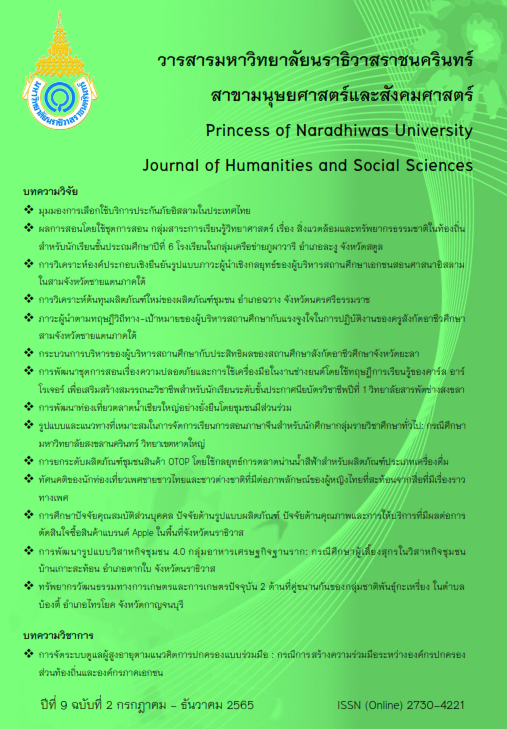Confirmatory Factor Analysis of Strategic Leadership Model of Islamic Private School Administrators in Three Southern Provinces
Main Article Content
Abstract
This research aimed to validate the consistency of the strategic leadership model of Islamic private schools’ administrators in the three border provinces with empirical data. 278 out of 984 administrators of Islamic private schools in the three border provinces were drawn as a sample group based on the guidelines of Krejcie and Morgan and were randomly stratified according to the size of the schools and then were simply drawn using lottery technique. The instrument used in the research was a 5-scale questionnaire with its validity between .05 and 1 and its reliability value of .979. Data were analyzed using SPSS and LISREL programs.
The results of the research showed that the strategic leadership model of Islamic private schools’ administrators in the three southern border provinces including core components and subcomponents were consistent with the empirical data. The second confirmatory component analysis showed that the Chi-Square(χ²) equals 317.58; the degrees of freedom (df) equals 151 index; the level of Goodness of Fit Index (GFI) and the level of Adjusted Goodness of Fit Index (AFGI) were 0.90 0.86, respectively; Standard Root Mean Square Residual (SRMR) was 0.0091; and Root Mean Square Error of Approximation (RMSEA) was 0.063. In addition, the significance of core components included as follows: Strategy Formulation (L=1.00) Strategy Implementation (L=0.94) Strategy Control and Assessment (L=0.94) High Thinking Process (L=0.83) Organizational Direction Setting (L=0.81), respectively.
Article Details

This work is licensed under a Creative Commons Attribution-NonCommercial-NoDerivatives 4.0 International License.
References
คมกฤช พรหมฉิน. (2560). การวิเคราะห์องค์ประกอบเชิงยืนยันของภาวะผู้นำเชิงกลยุทธ์ ในศตวรรษที่ 21 ของผู้บริหารสถานศึกษา (วิทยานิพนธ์ครุศาสตร์มหาบัณฑิต). มหาวิทยาลัยราชภัฏรำไพพรรณี, จันทบุรี.
จรูญรัตน์ วัฒนศักดิ์ศิริ. (2561). การพัฒนาภาวะผู้นำเชิงกลยุทธ์ของหัวหน้าสาขาวิชาในมหาวิทยาลัยเทคโนโลยีราชมงคล (วิทยานิพนธ์ปรัชญาดุษฎีบัณฑิต). มหาวิทยาลัยมหาสารคาม, มหาสารคาม.
ณิรดา เวชญาลักษณ์. (2560). ภาวะผู้นำทางการบริหาร. กรุงเทพฯ: สำนักพิมพ์แห่งจุฬาลงกรณ์มหาวิทยาลัย.
ทรงศักดิ์ ภูสีอ่อน. (2551). การประยุกต์ใช้ SPSS วิเคราะห์ข้อมูลงานวิจัย (พิมพ์ครั้งที่2). กาฬสินธุ์: โรงพิมพ์ประสานการพิมพ์.
ธัชชนันท์ มโนเพ็ชรเกษม. (2560). องค์ประกอบของภาวะผู้นาเชิงกลยุทธ์ของผู้ปฏิบัติวิชาชีพกายอุปกรณ์ในประเทศไทย (วิทยานิพนธ์ปรัชญาดุษฎีบัณฑิต). มหาวิทยาลัยคริสเตียน, นครปฐม.
นงนภัส วงษ์จันทร, เนตรชนก ศรีทุมมา, จันทร์จิรา วงษ์ขมทอง, และ ปราณี มีหาญพงษ์. (2561). โมเดลความสัมพันธ์เชิงโครงสร้างของภาวะผู้นากลยุทธ์ ความยึดมั่นผูกพันต่อองค์กร และประสิทธิผลของงานการพยาบาลผู้คลอดในโรงพยาบาลระดับทุติยภูมิ สังกัดกระทรวงสาธารณสุข. วารสารมหาวิทยาลัยคริสเตียน, 24(4), 588 – 599.
พิชิต โกพล. (2559). การพัฒนาตัวบ่งชี้ภาวะผู้นำเชิงกลยุทธ์ของผู้บริหารสถานศึกษาที่ส่งผลต่อประสิทธิผลโรงเรียนขยายโอกาสทางการศึกษา สังกัดสำนักงานคณะกรรมการการศึกษาขั้นพื้นฐาน ในภาคตะวันออกเฉียงเหนือ (วิทยานิพนธ์ปรัชญาดุษฎีบัณฑิต). มหาวิทยาลัยราชภัฏสกลนคร, สกลนคร.
มนสิชา ธรรมรักษ์. (2561). ความสัมพันธ์ระหว่างภาวะผู้นำเชิงกลยุทธ์ของผู้บริการสถานศึกษากับการบริหารงานวิชาการของโรงเรียนในเครือสวนกุหลาบวิทยาลัย (วิทยานิพนธ์ศึกษาศาสตรมหาบัณฑิต). มหาวิทยาลัยเทคโนโลยีราชมงคลธัญบุรี, ปทุมธานี.
เยาวรินทร์ ยิ้มรอด. (2559). ภาวะผู้นำเชิงกลยุทธ์ของผู้บริหารสถานศึกษากับคุณภาพผู้เรียนของโรงเรียนมาตรฐานสากล ระดับมัธยมศึกษา สังกัดสำนักงานศึกษาธิการจังหวัดในภาค ตะวันตก (วิทยานิพนธ์ศึกษาศาสตรมหาบัณฑิต). มหาวิทยาลัยศิลปากร, เพชรบุรี.
รัชตา กาญจนโรจน์. (2560). ภาวะผู้นำเชิงกลยุทธ์ที่มีอิทธิพลต่อระดับการมีส่วนร่วมของผู้บริหารสถานศึกษา สังกัดสำนักงานเขตพื้นที่การศึกษาประถมศึกษาเพชรบุรี เขต 1 (วิทยานิพนธ์บริหารธุรกิจมหาบัณฑิต). มหาวิทยาลัยนานาชาติแสตมฟอร์ด, เพชรบุรี.
วัชรพงษ์ สำราญรมย์. (2561). ความคิดเห็นของข้าราชการครูต่อภาวะผู้นำเชิงกลยุทธ์ของผู้บริหารสถานศึกษา สังกัดองค์การบริหารส่วนจังหวัดนครราชสีมา (วิทยานิพนธ์ปริญญาครุศาสตร มหาบัณฑิต). มหาวิทยาลัยราชภัฏชัยภูมิ, ชัยภูมิ.
สุภมาส อังศุโชติ สมถวิล วิจิตรวรรณา รัชนีกูล ภิญโญภานุวัฒน์. (2554). สถิติวิเคราะห์สำหรับการวิจัยทางสังคมศาสตร์และพฤติกรรมศาสตร์ เทคนิคการใช้โปรแกรม LISREL (พิมพ์ครั้งที่ 3). เจริญดีมั่นคงการพิมพ์.
เหมือนฝัน นันทิยกุล. (2562). ภาวะผู้นำเชิงกลยุทธ์ของผู้บริหารสถานศึกษาที่ส่งผลต่อการบริหารโรงเรียนเอกชนสู่ความเป็นเลิศในจังหวัดนครปฐม (วิทยานิพนธ์ครุศาสตรมหาบัณฑิต).มหาวิทยาลัยราชภัฏนครปฐม, นครปฐม.
อับดุลอาซิซ เจ๊ะมามะ. (2556). ภาวะผู้นำและบทบาทของอิหม่ามในการจัดการศูนย์การศึกษาอิสลาม ประจำมัสยิด (ตาดีกา) ในจังหวัดนราธิวาส (วิทยานิพนธ์ศึกษาศาสตร์มหาบัณฑิต). มหาวิทยาลัยสงขลานครินทร์, ปัตตานี.
Bentler, P.M. (1990). “Comparative Fit Indexes in Structural Models,” Psychological Bulletin. 107(2), 238 - 246.
Bloom, B., S. (1956). Taxonomy of Educational Objectives. New York: David Mckay Company.
Comrey, A. L., & Lee, H. B. (1992). A First Course in Factor Analysis (2nd ed.). New Jersey: Lawrence Erlbaum Associates. Retrived from http://www.ingentaconnect.com/content/apl/lcbi
Hair, J. F. Jr. Black, W. C., Babin, B. J. Anderson, R. E. and Tatham, R. L. (2006). Multivariate data analysis. (6th ed). New Jersey: Prentice Hall.
Kline, R. B. (2005). Principles and practice of structural equation modeling. New York: Guilford Press.
Krejcie, R. V. & Morgan, D. W. (1970). Determining Sample Size for Research Activities, Educational and Psychological Measurement, 30(3), 607 – 610.


